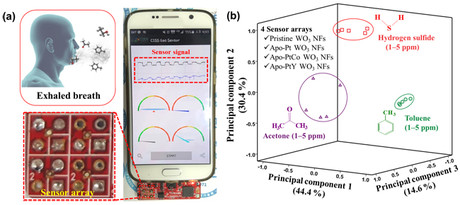Breathalyser app diagnoses disease

Imagine if diagnosing a disease was as easy as breathing into a phone app. No needles and blood samples, no delayed diagnosis. This may soon be possible thanks to new technology developed in South Korea.
Leveraging a phone app, the researchers use gas concentrations in human breath to diagnose certain diseases.
Working under Professor Il-Doo Kim, the Korea Advanced Institute of Science and Technology (KAIST) research team has developed diagnostic sensors using protein-encapsulated nanocatalysts, which can diagnose certain diseases by analysing biomarker gases in a person’s exhaled breath.
Human breath contains diverse components including water vapour, hydrogen, acetone, toluene, ammonia, hydrogen sulfide and carbon monoxide, some of which are closely related to diseases such as asthma, lung cancer, type 1 diabetes mellitus and halitosis.
The researchers started the process by capturing exhaled breaths in a Tedlar bag and the captured breath gases were subsequently injected into a miniaturised sensor system, similar to an alcohol breathalyser. It was then possible to rapidly analyse exhaled breath with a simple process that detects trace changes in exhaled breath components, contributing to early diagnosis of diseases.
The research team developed a disease diagnosis platform that recognises individual breathing patterns by using a multisensor array system with diverse sensing layers and heterogeneous catalysts, so that the people can easily identify health abnormalities. Using a 16-sensor array system, physical conditions can be continuously monitored by analysing concentration changes of biomarkers in exhaled breath gases.
Professor Kim said, “New types of heterogeneous nanocatalysts were synthesised using protein templates with sizes around 2 nm and functionalised on various metal oxide nanofibre-sensing layers. The established sensing libraries can detect biomarker species with high sensitivity and selectivity.
“The new and innovative breath gas analysis platform will be very helpful for reducing medical expenditures and continuous monitoring of physical conditions.”
Patents related to this technology were licensed to two companies in March and June this year.
The study’s results were published in the Journal of the American Chemical Society.
In Conversation with Australian Institute of Digital Health CEO, Anja Nikolic
Hospital + Healthcare speaks with Australian Institute of Digital Health CEO Anja...
Cutting-edge digital health tools putting plastic, silicon and steel to the sword
The Australian Digital Health Agency's Chief Digital Officer sets out some sustainable...
How are AI models approved for use in health care?
Hospital + Healthcare speaks with the Therapeutic Goods Administration to...



![[New Zealand] Transform from Security Awareness to a Security Culture: A Vital Shift for SMB Healthcare — Webinar](https://d1v1e13ebw3o15.cloudfront.net/data/89856/wfmedia_thumb/..jpg)
![[Australia] Transform from Security Awareness to a Security Culture: A Vital Shift for SMB Healthcare — Webinar](https://d1v1e13ebw3o15.cloudfront.net/data/89855/wfmedia_thumb/..jpg)




